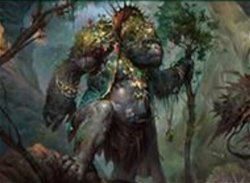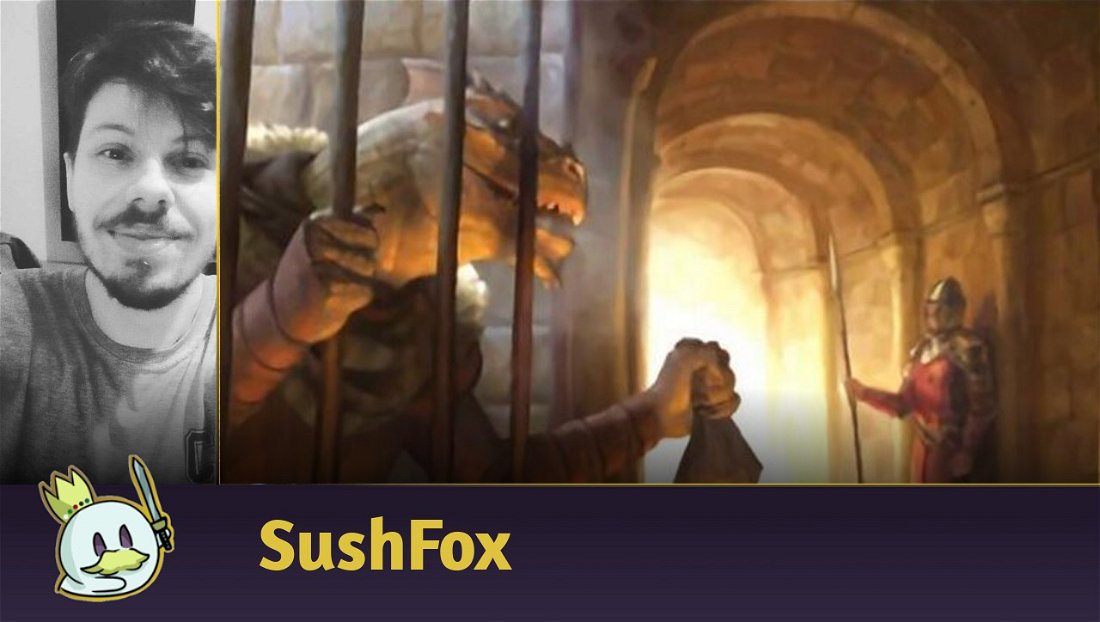About the Deck
I mentioned Mono Green Aggro in my first Deck Tech here for Cards Realm, and also in my most recent guide
— and today the day has come to make a guide dedicated to it.
Like a good Aggro, this deck seeks to win quickly, leaving little response time for opponents. The idea is to play bigger and bigger creatures and protect them from removal when necessary, paving the way to victory, ideally in a maximum of 5 turns.
One more cool thing about this deck, is that it is currently one of the tier 1 decks that uses less rare or mythic cards, which means it won't take as many Wild Cards to build it on MTGArena.

A game with this deck tends to be well paced, Ascendant Packleader on turn 1, Werewolf Pack Leader on turn 2, Old-Growth Troll on 3, Ulvenwald Oddity or Esika's Chariot at 4 and Invoke the Ancients at 5 will be a pretty common game to see playing with this list — and if all goes well on turn 4 or 5 we already have lethal damage.
With all this speed, the trend is for us to be able to easily handle the format's control decks like Jeskai, Dimir or Grixis. I'll go into more detail in the proper section, but we'll have work to deal with Midranges like Esper, Naya and Jund, which are decks that can respond better and faster to Aggro.

One of the best cards in the deck is Invoke the Ancients, which manages to give a very high value, and is usually the last nail in the coffin for our opponents. But as I said before, this tends to be a very fast-paced game, so the set of all cards working together is what makes this deck stand out.
During the game we don't need to worry about looking for any specific card, but it will be interesting if we can protect one or another card that gives us more advantage, such as Werewolf Pack Leader, which can be protected by Snakeskin Veil or some versions of this deck use Tamiyo's Safekeeping, which can be interesting if your meta has numerous Aggros.
It's also worth mentioning Blizzard Brawl, which is a removal that will also allow us a free attack, as our creatures will also gain indestructible.
Let's go to the list:
I mentioned that some lists run Tamiyo's Safekeeping, it's also possible to play Inscription of Abundance and Devouring Tendrils as alternate cards, or extras — it's worth checking your Metagame for these changes. Froghemoth is good when facing decks that use the graveyard, and Masked Vandal is great against Naya Runes.
Mulligan and Postures
I should stress the importance of timing with this deck, especially against Control decks. There will be times when we wonder whether we should cast certain creatures, and it's usually best to do so. I'll illustrate with my first example:
We play Ascendant Packleader on turn 1, Werewolf Pack Leader on turn 2 and attack with Ascendant Packleader, 2 damage, do Old-Growth Troll on 3 and attack with Ascendant Packleader and Werewolf Pack Leader, total 7 damage dealt. In the fourth turn we play and also attack with Ulvenwald Oddity, 13 damage, plus the previous 7, and we close 20 damage. Of course this is ideal, and we will often have removals getting in the way, but if we don't have mishaps it's possible to win as soon as turn 4!
It's important not to let the games get too long because that's how Control and especially Midrange start to have an advantage over Aggro, so I focus on reducing opponents' life to zero.
Mulligans
Although it is possible to close games on turn 4, it is not interesting to mulligan just to try to get the ideal hand, even with fewer cards. It must be remembered that the mulligan can also make the hand worse, in addition to reducing the total number of cards in the starting hand by 1.
I nominate Mulligan only if we don't have plays for the first 2 turns. It will be relatively common to have no plays on turn 1, but not playing anything on turn 2 will be terrible for Aggro, playing only on 3 is practically unthinkable!
The ideal hand, the one that can close the game on turn 4, looks like this:

But something like this hand will be more common and acceptable:

Sideboard Guide
Jeskai Control
The tendency is that this is one of the best games for Aggro, as they use a maximum of 8 or 10 creatures, all with a minimum cost of 4, so we have to make the most of their clean board, as the opponent will generally have 6 removals or less. We have to do as much damage as possible until turn 3, before the creatures start appearing across the field.
In game 2 our opponent will have more removals and will remove counterspells, which are dead cards in that game, so we will have more work, and thus I like to add Toski, Bearer of Secrets.
Side Out

Side In

Dimir Control
Another Control with few creatures, but here we need to try to speed up our game with Sculptor of Winter and Jewel Thief, to play Ulvenwald Oddity and Esika's Chariot and even Invoke the Ancients, so they will have fewer removals than we have threats.
In Game 2, the opponent's deck shouldn't change much, but we will add more protections and creatures.
Side Out

Side In

Temur Control / Izzet Dragons
There are several deck variants that use red and at least one more color, in general they all play Goldspan Dragon and efficient spells to control the game until they can play it and some other huge creature, like Hullbreaker Horror, Titan of Industry or even the not-so-big Hinata, Dawn-Crowned, but the logic is the same in all of them: get to the late game to turn the tide with big creatures.
In this chapter, I try to encompass all those decks that we haven't covered before, but that we will have the same behavior against them, especially attempting to attack fast and end the game before it's too late.
For all of them, we're going to add Tangletrap to deal with the dragon once it comes in, and we'll add more protections so creatures that don't get countered can stay in play a bit longer, especially our larger threats.
Side Out

Side In

Orzhov Control
An exception to Control, Orzhov has many creatures and is perhaps closer to Midrange, as it manages to control the battlefield while posing threats. The ideal in this game is not to trade creatures, except for Luminarch Aspirant.
Here we will try to remove the creatures using Blizzard Brawl and Master's Rebuke, eventually we will also manage to play Inscription of Abundance with Kicker. And speaking of exception, this will be one of the very few games that it is okay to take to the late game, so here we will exchange pieces like Ascendant Packleader for cards that will give us card advantage and resilience, like Reckoner Bankbuster.
Side Out

Side In

Esper Midrange
Esper Midrange will be a very complicated game, as it has creatures that can grow by themselves, and they still have the help of Raffine, Scheming Seer.
Here we will try to eliminate Luminarch Aspirant as soon as possible, we should also attempt to prevent Raffine from triggering and, if possible, not exchange our creatures with the opponent's during combat. The ideal is to always attempt to make attacks that favor our board.
The side will be similar to what we do against Orzhov, but I like to keep at least 2 Snakeskin Veil.
Side Out

Side In

Naya Enchantments
Possibly, the most difficult game, as in addition to having many creatures, this deck consistently manages to gain life, making it very difficult for us to make that long-awaited victory on turn 4.
Here the creatures can also get big and fast, and they can still count on the help of Valorous Stance to become indestructible at instant speed, so it's also not good to try to force trades during combat.
It's helpful to cast Blizzard Brawl before combat to remove the blocking creature before we enter the combat phase, or else reveal opponents' tricks. We will also count on Master's Rebuke as a trick in later turns, in response to the opponent leaving it indestructible, for example.
And finally, we will have Outland Liberator, which - on the Nightbound - can remove important enchantments before they declare blockers
Side Out

Side In

Alternate Card Choices
There are options to use in the main deck like Primal Adversary and Unnatural Growth, but I find these cards particularly slow — as I said during the article, this deck has to try to close the game as soon as possible, so Unnatural Growth would be underused in my opinion. Primal Adversary is perhaps still versatile enough to try to explore it further, but so far, I prefer the list without it.
On the sideboard, we have Broken Wings as an alternative to Tangletrap, and we have lists that run Weathered Runestone and Pithing Needle, but again, I don't think it's very interesting to attempt to control the game even lightly, so I also don't like to use Froghemoth, Workshop Warchief or Avabruck Caretaker as some lists do. I have the impression that these cards end up being slow — maybe I would still consider Froghemoth, as it has haste and trample, and can still be effective once it enters the battlefield.
Conclusion
Did you like the article? Which deck do you want to know next? Leave your comment!
Until the next time!















— Comments 0
, Reactions 1
Be the first to comment